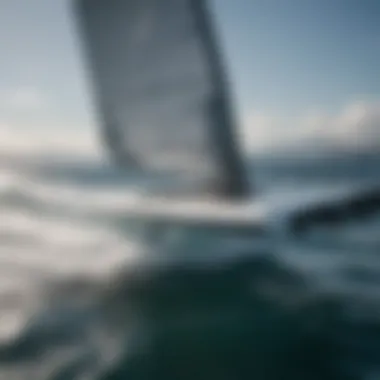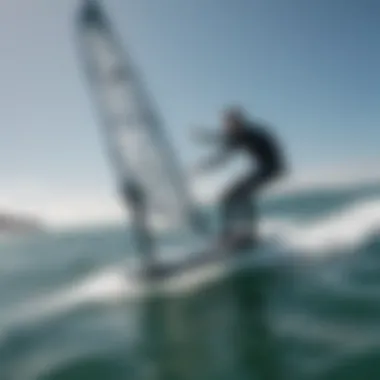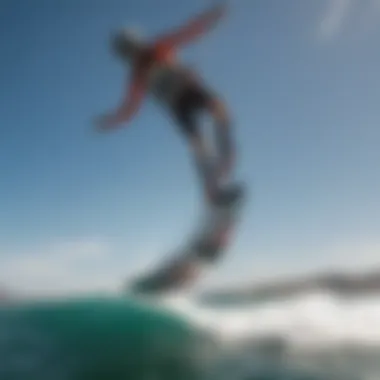Understanding Foiling Sailboards: A Complete Guide


Intro
In the realm of board sports, the marriage of technology and technique gives rise to fascinating innovations. One such marvel is the foiling sailboard, a vessel that offers riders an extraordinary experience above the water, transforming the way they engage with wind and waves. The elegance of gliding above the surface is not just for show; it revolutionizes kiteboarding and enhances its aesthetic appeal.
Foiling sailboards stand apart due to their unique design. They utilize a hydrofoil, which is an underwater wing that generates lift when speed is achieved. This allows the board to rise above the water, leaving behind a whisper of waves rather than a tumultuous splash. Foiling isn’t simply an evolution; it’s a paradigm shift that has opened new frontier for both leisure and competitive riding.
As kiteboarding enthusiasts look to embrace this thrilling experience, understanding the componentry and dynamics involved is paramount. The following sections will arm both novices and seasoned individuals with essential insights into equipment, technique, and evolving technology pertinent to foiling sailboards. We also emphasize the importance of safety, ensuring that the thrill of foiling is matched by informed riding practices.
Prelude to Foiling Sailboards
In the realm of board sports, foiling sailboards stand out as a fascinating blend of hydro-dynamics and aerial prowess. This section lays the groundwork for understanding what makes foiling unique and why it has captured the interest of kiteboarders and enthusiasts alike.
Foiling sailboards, often perceived as the next evolution in kiteboarding, evoke discussions around their intricate mechanics and the exhilaration they offer. There’s a certain thrill in riding above the water, only gliding on the foil, leaving the conventional constraints of traditional sailing behind. The technology allows riders to harness the wind more effectively and gain impressive speeds while experiencing less drag.
The importance of discussing foiling sailboards stems not only from their growing popularity but also from their impact on the way kiteboarding is approached. This guide will elucidate essential elements such as the principles of lift and drag, the structural components of the boards, and safety considerations, all contributing to a better understanding of the sport. Whether you're just dipping your toes in foiling or looking to refine advanced maneuvers, grasping these foundational ideas is essential for progress.
Definition and Origins of Foiling
The concept of foiling isn’t entirely new; its roots can be traced back to the early adaptations of surfboards and sailboats. Originally designed by inventors who sought to reduce water drag and increase speed, the first foiling apparatuses appeared in the mid-20th century. From early attempts at hydrofoils to today’s cutting-edge sailboards, the journey of foiling illustrates a continual quest for performance enhancement in water sports.
Fundamentally, a foil consists of a submerged wing that generates lift when subjected to flow. This principle allows the rider to ascend above the water’s surface, significantly reducing resistance. The sensation of levitating above the waves is not just thrill and chills; it's also an engineering feat that reflects how far water sports culture has come.
The Evolution of Kiteboarding Techniques
Kiteboarding itself has evolved tremendously over two decades. The advent of foiling has ushered in a whole new set of techniques and styles that push the boundaries of what’s possible on the water. In the early days, riders operated with simple boards and basic kites, relying heavily on traditional wind and wave patterns. However, the introduction of foiling has transformed not just how we ride but also when we can ride.
With modern foiling gear, riders can harness minimal winds to catch air in a way that regular boards simply cannot. This innovation allows kiteboarders to venture out in varying conditions—light winds that would have once kept riders at bay are now perceived as optimal circumstances for foiling.
Furthermore, adapting to foiling techniques requires a shift in thinking. Movements that might have sufficed on a standard board must be recalibrated for a foiling setup. Riders need to re-assess their balance, control, and rhythm. The evolution encapsulates a learning journey where established techniques meet novel approaches, ensuring that the sport remains dynamic and compelling.
In summary, foiling sailboards represent a spectacular convergence of technology, wind, and water. This guide aims to dig deeper into the mechanics, components, and evolving techniques of foiling, setting the stage for a more enriched understanding of this captivating sport.
Components of Foiling Sailboards
Understanding the components of foiling sailboards is crucial. The elements that make up these boards not only determine how well they perform, but they also influence the rider's experience on the water. Each component, from the foil structure to sail design, works cohesively to elevate how a foiling sailboard glides above the waves, managing lift and drag efficiently. By delving into the building blocks of these boards, riders can make informed decisions that enhance their performance and safety in various conditions.
Foil Structure and Materials
The foil structure is the heart of any foiling sailboard. It's made up of the mast, wings, and fuselage, and each piece has its own role in achieving lift.
The mast connects the board to the wing, which sits submerged in water. A wider wingspan may allow for a smoother ride, providing more lift. Typically crafted from carbon fiber and aluminum, the materials used in the foil vary.
- Carbon fiber: Known for its strength-to-weight ratio, carbon offers durability while keeping the weight low.
- Aluminum: While heavier, it provides an affordable option for beginners.
- Foil shape: The profile of the wings also affects performance; some wings are designed for speed, while others are built for stability.
Understanding these materials and how they influence lift and drag is essential for a rider’s progression and adaptability to different water conditions.
Sail Design Specifics
Next, we turn our attention to the sails. They are not just a piece of fabric; they are a critical element that captures wind energy and translates it into motion. The design specifics can drastically alter a rider's experience.
The key elements to consider include:
- Shape: Sails can be flat or rounded. Flat sails can generate speed, while rounded ones can provide better lift in lighter winds.
- Size: Depending on conditions, different sail sizes may be deployed. Larger sails catch more wind but can be harder to control in strong winds.
- Material: Sails are often made from durable polyester or ripstop nylon, allowing them to withstand harsh conditions while maintaining shape. Their construction affects both performance and longevity.
A well-designed sail can transform a foiling experience, allowing for smoother transitions and enhanced speed.
Board Characteristics and Variations
Now, let’s dive into the board itself. The board serves as the foundation on which everything else relies. Its design influences how the rider interacts with the water and the wind. Several characteristics define the board's function:
- Length and Width: Longer boards offer more stability, making them beginner-friendly, whereas shorter boards are more maneuverable for advanced tricks.
- Rockers: The curvature of the board affects how well it rides over chop or flat water. A high rocker can help in rough conditions, while minimal rockers are better for speed.
- Tail Design: Some boards come with rounded tails for smoother transitions, while square tails cater to speed and performance.
By selecting the right board characteristics, individuals can tailor their foiling experience, achieving a balance between performance and ease of use.


Understanding the components of your foiling setup allows riders to unlock their potential and adapt to varying conditions effectively.
In summary, the components that make up foiling sailboards are intricately linked to performance, safety, and rider satisfaction. From the foils and sails to the boards themselves, each aspect contributes to the engaging experience of riding above the waves, adapting to wind and water challenges with finesse.
Mechanics of Riding a Foiling Sailboard
The mechanics of riding a foiling sailboard is not just about sailing; it's a delicate dance of physics, skill, and instinct. At its core, the ride involves gaining and maintaining lift, balancing on the board, and maneuvering with finesse. Understanding these mechanics can not only improve one's skill but also enrich the overall experience on the water.
Understanding Lift and Drag
Fundamental Physics of Foiling
Fundamental physics in foiling revolves around the concepts of lift and drag. Lift is generated when water flows over the foil, creating a pressure difference that elevates the board out of the water. This concept is crucial because achieving lift allows for a smoother ride and reduces resistance. Think of it as riding a wave without actually being in the wave; you're gliding above the chaos beneath.
A key characteristic here is the angle of attack. This angle dictates how effectively lift is generated. A positive angle means greater lift but increases drag, while too steep an angle may cause stalling. Striking the right balance is essential; too much drag could lead to frustrating rides, especially in tricky conditions. Learning this can shave seconds off your time or make the difference between a successful takeoff and a belly flop into the water.
The unique feature of the physics of foiling is the ability to harness natural forces in a way that keeps the rider gliding effortlessly. This synergy of lift and drag emphasizes how important technique is for successful foiling. For a beginner, understanding these principles can be daunting, but mastering them provides a satisfaction akin to an artist perfecting their craft.
Role of Speed in Lift Generation
Speed plays a pivotal role in generating lift. Simply put, the faster you go, the more lift is created. When the sailboard picks up speed, the foil interacts with water more aggressively, essentially tearing through the liquid and creating that lift necessary for a smooth ride. It's almost like pushing off the ground to jump higher; momentum is your friend.
Speed isn't just a bonus; it's a lifeline. A key characteristic is the need for consistent speed during turns and maneuvers to maintain lift. Too slow, and you risk dropping back into the water, while too fast can lead to losing control. Thus, maintaining a speed between 12 to 20 knots is generally ideal for most intermediate riders.
Additionally, the unique feature of speed is its relationship with the rider’s body. Weight transfer must be frequent and calculated. Chasing speed can create exhilaration, but managing that speed is what differentiates a skilled rider from a novice. As one learns to determine their speed threshold, the foiling adventure swiftly becomes both a mastery of physics and an expression of personal style.
Techniques for Balancing
Body Positioning
Body positioning is critical in keeping balance on a foiling sailboard. The core must remain engaged while moving fluidly with the board. A well-balanced rider often finds that their positioning can dramatically affect the overall ride. The main characteristic involves keeping your body low to maintain stability. If you're standing tall, you're essentially acting like a sail in the wind—a bad idea for stability.
A beneficial choice for balancing is to adopt a neutral stance—slightly bent knees and a forward lean help lower your center of gravity, allowing for better control during directional shifts. The sensation of being on a foiling sailboard feels akin to surfing but with added height. It's exhilarating but requires careful attention.
The unique aspect of body positioning is dynamic; it shifts as the water conditions change. One must always be ready to adjust their stance. Those new to foiling may find this aspect challenging, but learning to adapt is part of the journey, and it's incredibly satisfying once you grasp it.
Weight Distribution Strategies
Weight distribution strategies are just as essential as body positioning. The concept revolves around shifting your weight to help steer and stabilize the board during various maneuvers. By strategically spreading your weight between your front and back foot, you can manipulate how the foil interacts with water.
A notable characteristic of effective weight distribution is the forward hunch. Leaning slightly forward can increase lift, but leaning too far can lead to nose dives. Conversely, pushing back can peel off speed but help rein in a ride gone rogue. This dynamic gives you a sense of freedom while also requiring a level of awareness and instinct—you start feeling the board beneath you.
One must also consider the unique feature of weight distribution's adaptability. Conditions can change rapidly, requiring quick shifts in weight allocation. Practice makes perfect, and with enough time spent on the water, it turns into an almost intuitive process. Beginners may find it tricky at first, but those who stick with it will unlock the fullness of foiling.
Mastering these techniques is like weaving a tightrope; it takes practice, but the reward is exhilarating.
With a solid grasp of these mechanics, riders can set themselves up for impressive performances, no matter the environmental conditions. Whether you're racing against the wind or enjoying a leisurely glide, understanding these principles helps you elevate your foiling experience to new heights.
Advantages of Foiling Sailboards
Foiling sailboards have burgeoned into a compelling segment of the kiteboarding landscape, offering riders a kaleidoscope of benefits that stretch beyond the traditional kiteboarding experience. Understanding the advantages associated with foiling can significantly influence a rider's performance and enjoyment on the water. Let’s dive into some highlights of what makes foiling an intriguing venture for enthusiasts.
Enhanced Speed and Performance
One of the most gripping advantages of foiling sailboards is their remarkable speed capabilities. Riders often find themselves zipping across the water, leaving behind typical drag and resistance. This enhanced speed isn't merely about getting from point A to B at a swift clip; it encapsulates a thrilling sensation that you’re flying just above the water's surface.
The mechanics behind this speed are grounded in physics. When lifted by the foil, the board rises above the water. This elevation dramatically reduces the contact points, translating to less friction and, subsequently, higher speeds. A well-tuned setup can see some skilled riders reach speeds that would be considered exhilarating in traditional board sports.
Reduced Water Resistance


Speaking of physics, reduced water resistance plays a pivotal role in the performance of foiling sailboards. When you're riding a regular board, the added drag from the hull creates considerable resistance, slowing down your ride. With foiling, the board's elevation minimizes this contact with the water, leading to an overall smoother experience.
Think of it like riding a bicycle on a flat road compared to one filled with potholes. The smoother the road, the quicker you can zip along; likewise, with lesser resistance, riders can push their limits further. This capability becomes vital when navigating choppy waters or gusty winds, where foil users can maintain their stability and traction without fighting against water drag.
Increased Versatility Across Conditions
Versatility is another critical gem in the crown of foiling sailboards. Unlike traditional kiteboarding, where certain wind and water conditions can be make-or-break for a ride, foiling allows riders to adapt more readily to varying elements. Whether the winds are light or strong, and regardless of water conditions, the ride remains achievable with the right techniques and adjustments.
For instance, in lighter winds, foiling enables kiteboarders to harness the power of their kite effectively while still getting that exhilarating ride. In stronger winds, the ability to lift off further enhances control, allowing for moves that might feel impossible on a standard surfboard or kiteboard. Riders can go from flat water to choppy seas without losing that magical ride, which opens up a variety of landscapes for exploration.
"Foiling is not just about the ride; it's a dance with the elements, where adjustments to technique open up new worlds of possibilities."
With these advantages, it's evident why so many kiteboarders are drawn to foiling. It transforms the relationship with the water, enhancing speed, reducing resistance, and broadening the horizons for those adventurous enough to take on the challenge. Understanding these specific benefits paves the way for kiteboarders—be they novices or veterans—to make informed decisions about embracing this innovative riding style.
Challenges in Foiling
In the realm of foiling sailboards, challenges abound, and recognizing them is crucial for anyone serious about engaging in this exhilarating sport. Novices and seasoned riders alike need to acknowledge the hurdles they may face when navigating the nuances of foiling. Understanding these challenges not only enhances the overall foiling experience but also fosters a culture of safety and preparedness on the water.
Learning Curve for Beginners
For someone who’s just starting out, the learning curve can feel quite steep. It’s like trying to ride a bicycle for the first time, but the bicycle is on water, and there are numerous factors at play. Beginners often grapple with balancing on the board while simultaneously mastering the mechanics of the sail. The sensation of being lifted out of the water can be disorienting, akin to getting a brief glimpse of flying but without complete control.
Key aspects of the learning curve include:
- Understanding the foil: How it works in conjunction with speed and movement.
- Instinctive body positioning: Finding that sweet spot in balance can take time.
- Navigational skills: Beginners need to become adept at managing wind and water conditions while maintaining control.
Creating a progressive approach to learning can be immensely beneficial. Starting with a large, stable board can help, allowing new riders to gain confidence before transitioning to smaller, more agile boards. With practice and patience, the seemingly insurmountable hurdles can become manageable and, eventually, overcome.
Safety Considerations
When engaging in foiling, safety needs to be at the forefront, especially with the complexities of the sport. The thrill of ‘flying’ over the water comes with a set of risks that could lead to accidents if not understood and managed properly.
Potential Risks in Foiling
One needs to be aware of the potential risks in foiling, as they can affect not only the rider but also those around them. Some notable risks include:
- Impact injuries: The rigidity of the foil can cause serious harm if a rider falls or collides with something.
- Water hazards: Unseen obstacles beneath the surface can lead to dangerous situations.
- Inexperience: New riders may lack control, making them prone to accidents, especially in busy waters.
Understanding these risks aids in making informed decisions, such as choosing safer locations for practice and understanding wind patterns. Emphasis should be placed on gradual skill acquisition and self-awareness while riding, which can significantly mitigate potential mishaps.
"Safety doesn’t happen by accident; it’s a choice we make before we hit the water."
Protective Gear Recommendations
Another safety aspect that should not be overlooked is protective gear. Having the right equipment can turn a dangerous situation into a manageable one. Essential gear that every foiling sailor should consider includes:
- Helmet: Protects against head injuries from falls or collisions.
- Impact vest: Offers buoyancy and cushioning.
- Wetsuit: Keeps warm and protects from jellyfish or other marine life.
- Foot protection: Shoes or booties can prevent foot injuries when falling onto the board.
The uniqueness of protective gear lies in its preventive capability. It’s not just about looking good or feeling secure; it’s about recognizing the inherent dangers of the sport and taking conscious steps to protect oneself before they arise. Plus, the right gear can give riders the confidence to push their limits, knowing they are well-equipped to handle the unexpected.
In summary, while foiling offers unparalleled excitement and thrill, it's essential to stay cognizant of the challenges involved. By addressing the learning curve and emphasizing safety through protective gear and risk awareness, riders can ensure a fulfilling and secure foiling experience.
Progression in Foiling Techniques
Understanding the progression in foiling techniques is essential for both novice and experienced kiteboarders. It involves moving from fundamental skills to more complex maneuvers, allowing riders to enhance their performance and enjoy the sport to its fullest. Mastery of foiling techniques not only increases a rider’s confidence but also opens the door to a myriad of experiences on the water.
The transition in these techniques requires both practice and patience, emphasizing the need for a solid foundation before advancing. The journey can be challenging; however, the rewards are significant. Improved agility, speed, and the ability to ride under varied conditions contribute to a more fulfilling kiteboarding experience. Moreover, refining these techniques nurtures a deeper understanding of the sport, ultimately elevating the enjoyment of those who participate.
From Basic to Advanced Maneuvers


Transitioning from Traditional Kiteboarding
Transitioning from traditional kiteboarding to foiling represents a significant leap in skill and understanding. This process requires not only a shift in mentality but also a robust adaptation of techniques. This aspect highlights the dramatic differences in dynamics and balance between a standard kiteboard and a foiling setup. Riders accustomed to the stability of traditional boards may find the initial time spent learning the foil's nuances to be both a challenge and an adventure.
One key characteristic of this transition is the necessity of balance and body control. Riders must develop a sensitivity to their movements as even minor shifts can drastically affect performance. This transition is beneficial for those looking to ride more efficiently with minimal drag on the water. The unique feature here lies in how a rider learns to leverage speed, weight distribution, and foil lift to stay above the water, creating a smooth experience rather than the jarring feedback often felt in traditional kiteboarding.
However, the drawbacks do exist. Riders might feel overwhelmed during their learning phase, experiencing falls or lost balance more frequently. It's crucial to approach this transition gradually, as rushing can lead to safety concerns or discouragement.
Signature Moves in Foiling
Signature moves in foiling are the crescendo of a rider's technical journey, encapsulating the essence of what makes this sport exhilarating. These maneuvers, often showcasing style and finesse, provide an exciting end-goal for those mastering the fundamentals. A distinctive aspect of these moves is the unique combination of balance, speed, and timing required to execute them successfully. As riders progress, they begin to incorporate their personality into these moves, creating signatures that are uniquely their own.
What makes signature moves particularly appealing is the sense of accomplishment they bring. Successfully nailing a tricky trick can boost a rider’s confidence and inspire further experimentation. In this way, signature moves represent not just skill but a form of personal expression.
However, the journey toward mastering signature moves can be peppered with challenges. Riders must invest considerable time practicing at different conditions to comprehend how wind, waves, and foil dynamics interact. This prolonged effort can be frustrating but ultimately rewarding as these moves serve to elevate the riding experience for both the individual and those fortunate enough to witness them in action.
"Foiling transforms kiteboarding into a dance with the wind and water, each signature move narrating a story unique to the rider."
In essence, the progression in foiling techniques is marked by a rich tapestry of experiences. Both transitioning from traditional kiteboarding and perfecting signature moves contribute to an ever-evolving riding style and competence. As individuals learn, adapt, and create, they elevate not just their proficiency, but also the broader culture surrounding foiling in kiteboarding.
The Future of Foiling Technology
As the world of kiteboarding evolves, foiling sailboards are at the forefront of change, blending performance and innovation. The future of foiling technology holds significant importance in enhancing riders' experiences while also pushing the boundaries of design and performance.
Innovations in Equipment Design
The technological advancements in equipment design are nothing short of remarkable. Modern foiling sailboards now feature intricate designs that prioritize both agility and stability. With a greater emphasis on hydrodynamics, manufacturers have introduced new shapes and dimensions for the boards, aiming to minimize water resistance while maximizing lift.
Several innovations stand out:
- Modular Foil Systems: These allow riders to customize their setups easily according to conditions or personal preferences.
- Integrated Safety Features: New designs focus more on reducing the risks involved with foiling, offering features like automatic releases and improved buoyancy.
- Smart Technology Integration: Some brands are experimenting with smart gear that can provide real-time data on performance metrics, improving rider experience and safety.
Such advancements not only enhance performance but also encourage broader participation in the sport. With developments closely aligned to rider feedback, the future of equipment design will likely see even more personalized and user-friendly options.
Impact of Materials Science
Materials science is a cornerstone of advancements in foiling technology. The shift toward lighter, stronger materials can significantly impact performance and safety. Utilization of advanced composites, like carbon fiber and high-modulus polyethylene, has ushered in an era where durability doesn't come at the cost of weight.
Key points to consider include:
- Weight Reduction: Lighter materials allow for increased lift and better overall control since riders can navigate through the water with less effort.
- Enhanced Durability: Progress in materials also means that boards can withstand harsher conditions, extending the lifespan of equipment.
- Eco-Friendly Options: As the demand for sustainability grows, manufacturers are beginning to explore biodegradable or recyclable materials, aligning with global environmental goals.
These innovations don't just provide immediate benefits; they pave the way for ongoing developments that will define kiteboarding's future.
"The intersection of technology and performance in foiling sailboards represents not just an evolution, but a revolution in the sport."
In the long run, the future of foiling technology promises to redefine cycling through its commitment to innovation and sustainability, enhancing the joy of riding while ensuring that we respect the environment in which we enjoy these thrilling activities.
Finale and Perspectives
In wrapping up this comprehensive guide on foiling sailboards, it’s vital to reflect on the journey that this sport presents. Understanding foiling isn’t simply about knowing how to ride; it's about appreciating the mix of technology, skill, and environmental connection that defines this exhilarating niche of kiteboarding. Consider the way these boards glide above the water's surface, harnessing the power of wind and water to create a dynamic and responsive riding experience. This unique interaction demands respect and understanding, making the journey not only about mastering maneuvers, but also about fostering a deeper connection to the elements.
Summarizing the Foiling Journey
The foiling journey represents more than just the technical aspects; it is about the personal growth and evolution as both an athlete and an individual. From a novice taking their first uncertain steps to seasoned riders executing advanced maneuvers, every experience on a foiling sailboard reveals layers of learning. Consider how many aspirational kiteboarders start with the basics, grappling with the nuances of balance and technique. They might recall their first successful lift, the feeling of being airborne, the thrill that can only come from those moments when everything clicks.
"Foiling is not just a sport; it’s an experience that elevates your connection with nature."
As people progress, they pick up valuable lessons—resilience in the face of falls, patience as they refine their skills, and creativity as they begin to invent their own styles. Each rider’s journey is unique, but they all share a common thread: a fervent pursuit of connection with wind, water, and freedom. Along this path, sharing experiences with fellow riders can enhance the learning experience as friendships often blossom around shared passions for foiling.
Encouraging Exploration and Continued Learning
Encouraging exploration within the foiling community is crucial—that spirit of continuous learning can be just what keeps the excitement alive. As new techniques emerge and equipment advances, staying curious is essential. Participating in local foiling clubs or following online forums on platforms like Reddit can provide valuable insights. These sources not only share practical advice but also foster camaraderie among riders.
Consider seeking mentorship from experienced riders or even taking lessons as you delve deeper into the sport. Every ride presents opportunities for improvement and new strategies. Whether it’s navigating tricky winds or perfecting a maneuver, there’s always room for evolution. Plus, as the technology behind foiling sailboards rapidly changes with innovations in materials and design, it’s essential to stay informed about these advancements.
Ultimately, the world of foiling sailboarding is an ongoing adventure. Embracing the challenges, sharing knowledge, and exploring new techniques will not just enhance your skills; they will enrich your experience on the water. The journey is as rewarding as the destination, and it’s yours to navigate. Every wave, every breeze, every moment spent learning is part of what makes this sport remarkable.







